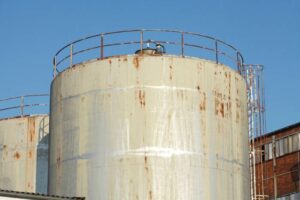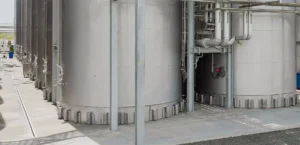There are disastrous consequences of aboveground storage tank leakage. It can damage the environment, harm human health, and lead to expensive cleanup and legal liabilities. However, preventing leakage is not impossible, and it is the responsibility of tank owners, operators, and inspectors to take proactive measures to reduce the risk of leakage. In this article, we will discuss the reasons for tank leakage. Importance of inspection, the solutions to leakage, and the best practices for reducing the risk of leakage.

Tank Leakage Reasons
Aboveground storage tanks can leak for various reasons, and it is essential to identify and address them before they escalate. One of the primary reasons for tank leakage is pipe corrosion. Corrosion occurs when the metal pipes and tanks come in contact with water, oxygen, and other corrosive agents. Over time, the metal weakens, and holes or cracks appear, leading to leakage. Corrosion can be prevented by using high-quality materials, coatings, cathodic protection, and regular maintenance.
Another reason for tank leakage is operator error. Human mistakes such as overfilling, underfilling, improper loading, unloading, and handling of hazardous materials can cause spills and leaks. Operators should be adequately trained, follow standard operating procedures, and use appropriate safety equipment to prevent errors.
Lastly, tank leakage can be caused by natural disasters such as earthquakes, hurricanes, tornadoes, and floods. These events can damage the tank structure, valves, and pipelines and cause leaks. Therefore, it is crucial to design and construct tanks that are resistant to natural disasters and have emergency response plans in place.
Aboveground storage tank Leakage Inspection
Leak detection is a critical aspect of tank inspection and maintenance. Regular inspections can help identify leaks in their early stages and prevent them from becoming larger problems. Tank inspections should be performed by trained and certified inspectors using advanced technology such as ultrasonic testing, magnetic particle inspection, dye penetrant testing, and visual inspection.
In addition to tank inspections, pipelines should also be inspected for signs of corrosion, damage, and wear. Pipeline inspection should include checking for leaks, cracks, dents, and other anomalies that can lead to leaks.
DirecTank Robust, corrosion resistance component.
Storage Tank Leakage Solution
- Identify the source of the leak: First, inspect the tank to locate the origin of the leakage. Look for visible cracks, holes, or rust damage that may be causing the problem.
- Turn off any connected systems and drain the tank: Before proceeding with repairs, make sure to turn off any pumps or other systems connected to the tank. Then, carefully drain the tank to prevent further damage and ensure a safe work environment.
- Clean and prepare the damaged area: Remove any dirt, debris, and rust from the leaking area using a wire brush or sandpaper. Creating a clean surface will make it easier to properly seal the leak.
- Apply an appropriate repair material: Depending on the size and location of the leak, you may need to use different repair materials such as epoxy putty, sealant tape, or fibreglass patching. Make sure to follow the manufacturer’s application instructions when using these products.
- Test for leaks: Once you’ve applied repair materials and allowed them to cure (as per manufacturer’s instructions), refill your tank partially and check for any signs of leakage. If no further leaks are detected, fully refill your tank and monitor it closely for several days to ensure that the repair has been successful.
- Conduct regular maintenance checks: To prevent future leaks and extend the life of your tank, implement a regular maintenance schedule. Check for signs of corrosion or damage, clean and lubricate necessary components as required, and consider replacing aging tanks as needed.
In cases where a leak is too large or complex to repair with DIY methods, it may be necessary to consult with a professional repair service for further assistance.
Tank Leakage protection
Preventing tank leakage is the best way to avoid the environmental, health, and financial costs associated with it. Here are some best practices for reducing the risk of leakage:
- Regular maintenance: Tanks and pipelines should be inspected and maintained regularly to identify and remedy potential defects and failures.
- Corrosion prevention: Use high-quality materials, coatings, and cathodic protection to prevent corrosion and reduce the risk of pipeline and tank failure.
- Operator training: Ensure that operators are adequately trained to handle hazardous materials, follow safety procedures, and use protective equipment.
- Emergency response planning: Develop and implement emergency response plans that include containment, cleanup, and reporting procedures in the event of a spill or leak.
- Leakage prevention technology: Install advanced leak detection and prevention technology such as automatic shutoff valves, sensors, alarms, and monitoring systems to detect and prevent leaks.
DirecTank is manufacturing high quality Floating roof seals for internal and external roof tanks best to prevent from liquid wastage through leakage and evaporation process.
Conclusion
Aboveground storage tank leakage can have severe consequences, but it is preventable. By understanding the reasons for leakage, conducting regular inspections, implementing solutions, and adopting best practices tank. Owners, operators, and inspectors can reduce the risk of leakage and protect the environment, human health, and financial resources.




